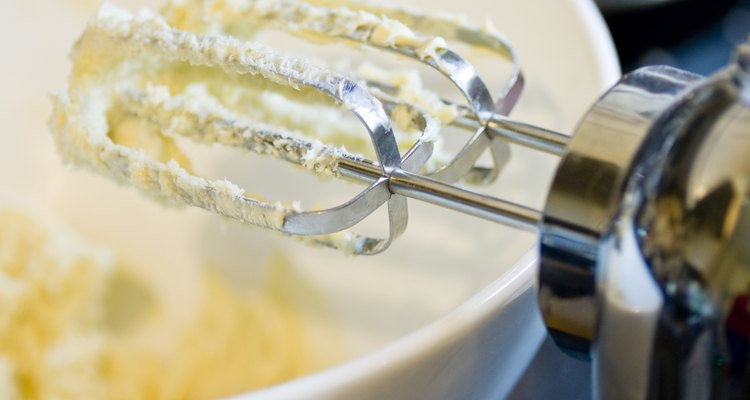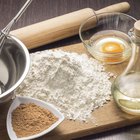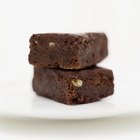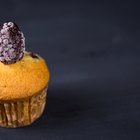
Thomas Rodger/iStock/Getty Images
When Arm and Hammer's founders, John White and James Church, invented baking soda in the late 19th century, they supplied homes across the U.S. with a cleaning solution, an odor absorber and a leavening agent for baked goods. In the 20th century, baking powder gradually replaced baking soda as a leavener, but the former is still applicable for rising cakes, cookies, muffins and cupcakes, depending on the composition of the rest of the ingredients. Avoiding unleavened, or flat, cake that has a tough, unappetizing texture, is essential in baking for achieving a successful result.
Carbon Dioxide and Gluten
When you add baking soda to cake batter, it releases carbon dioxide after it makes contact with an acidic ingredient. The carbon dioxide rises and pushes batter upward, and the gluten strands in flour, which adhere to one another, stretch and form the top of a cake. The carbon dioxide holds the batter in place as it bakes and solidifies in a heightened position. The final height of the cake depends on the amount of leavener, the rising impact of the rest of the ingredients, such as egg whites, and the type of baked good.
Baking Soda and Acid
If baking soda is the leavening agent in a cake recipe, it must also include an acidic ingredient to form carbon dioxide. An acidic ingredient in cake batter may include lemon juice, brown sugar, cocoa powder, yogurt, buttermilk or sour cream. Baking soda will begin releasing carbon dioxide as soon as it combines with acid. Bake a cake immediately after mixing the batter to ensure the cake rises as it bakes; otherwise, it will dissipate and the cake will not rise.
Baking Soda and Baking Powder
If a cake recipe includes no acidic ingredients, use baking powder, because it contains baking soda and cream of tartar, an acidic powder. The ingredients react with each other when they mix with liquid. The cornstarch, also included in the mixture, absorbs moisture and prevents the ingredients from reacting prior to mixing.
High Elevation Issues
If you live at an elevation higher than 2,500 feet, reducing the amount of baking soda in a recipe is necessary for achieving the best height for your cake. The reason is that carbon dioxide rises more rapidly at a higher elevation. It will fall, or depress in the center, if it rises too rapidly, which causes the gluten to stretch and the cake top to fall after it bakes. Decrease the amount of baking soda by 1/8 to 2/3 tsp., depending on the elevation.
Related Articles
What Causes My Cake to Fall When ...

What Causes Bubbles on Top of Cakes ...

What Kind of Flour to Use for Cupcakes?

What Are the Functions of Cream of ...

Is Butter or Shortening Better for Soft ...
Easy White Cake Recipe

Can You Bake Something Half Way & Then ...

Facts About How Baking Powder Might ...
Does Rain Affect Baking Cakes?

How Long Do You Have to Mix the Flour ...

What Are the Causes of Large Holes in a ...

How to Stop Cakes From Dropping
The Best Homemade German Chocolate Cake ...

Do I Need a Special Cake Mix for ...

What Is a Substitute for Potassium ...

Altitude Tips for Baking Brownies

What Causes Cupcakes to Fall?
How to Bake Cupcakes at High Altitudes
What Is the Purpose of Cream of Tartar ...

How to Make a Two-Layered Birthday Cake ...
References
Writer Bio
Based in Richmond, Va., Tara Carson has written articles for editorial and corporate online and print publications for more than 10 years. She has experience as an adjunct professor of nutrition at Northwest Christian University and holds a Bachelor of Science in journalism and nutrition from Virginia Commonwealth University.
Photo Credits
Thomas Rodger/iStock/Getty Images